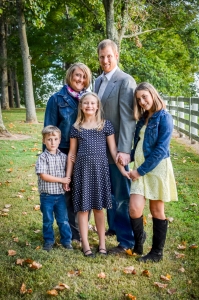Yesterday was my kids’ first day back to school. My husband and I went on a breakfast date. I attended chapel at my husband’s seminary. My house was quiet for 7 hours. And, if I’m honest, it was nice.
But as the time grew closer for my kids to get home, I grew more and more antsy. I wanted to know how their day went. I wanted to give them hugs and look in their eyes and see if they were really okay. I wanted to welcome them back into the quiet space, knowing full well it wouldn’t be quiet any more, but desiring even more their presence. So, I made them smoothies and soft pretzels and waited by the door to say, “Welcome home!”
Later, after the noise returned and the excitement wore off and the normal routine of our evening ensued, I thought, “Hmm, what was I so excited about?” But before bed, as I was tucking my youngest in, he said something along the lines of , “I can’t wait to come home tomorrow.”
And isn’t that what I really wanted?
I wanted my kids to want to come home. To come back to this place we share, to the noise and the mess, to the warmth and the love. I wanted them to walk through that door and immediately know they were wanted, they were missed, and they were loved.
They were welcomed.
 What if we translated this kind of “welcome home” into our church setting? I’m not saying we hand a smoothie and soft pretzel to each child that walks through the door, although that would be delicious. But what if we thought, “How can I let this child who is coming to worship service, to Sunday school, to Kids Church, to small group, know that they are wanted, missed, and loved?”
What if we translated this kind of “welcome home” into our church setting? I’m not saying we hand a smoothie and soft pretzel to each child that walks through the door, although that would be delicious. But what if we thought, “How can I let this child who is coming to worship service, to Sunday school, to Kids Church, to small group, know that they are wanted, missed, and loved?”
Here are five ideas that other ministers have shared with me for us to consider how we can say, “Welcome” each and every time we open the door to a returning child.
Say Their Name
Nothing says, “I know you” better to a child than simply saying their name when you see them. One little girl recently began attending our church and when I saw her on the second Sunday she was there I welcomed her by name. She literally stopped in her tracks, looked up at me and said, “How do you know my name?” I said, “Well, your mom told me last week and I remembered.” She responded with a simple but surprised, “Wow!” But later, she made sure to say good bye to me…by name.
Get on their Level
Once, a fellow minister at a conference, had all of us get down on our knees and “walk” around the room at half our size to see what the room looked like from a shorter vantage point. Tables at eye-level, ceilings far above our heads, signs and screens where we couldn’t read them; all of those experiences were helpful in understanding how a child feels. But nothing was more impacting than when half the adults were told to stand back up. Suddenly, those tall people became quite intimidating. Simply kneeling down so eye-to-eye contact is possible can remove that barrier and say, “I’m glad you are here!”
Ask a Question
A friend of mine told me that her trick to welcoming kids to the worship service is to make sure she has a question to ask about something they are involved in. For instance, if they play soccer, she’ll ask if they had a game and how it went. If they are in school, she’ll ask about their classes or how their tests went. She said, “I don’t need to know specifics, I just need to know basics, and they fill in the rest.” She’s also careful not to ask “yes” or “no” questions but ones where they can talk. Showing interest in someone says, “I want you here!” in very real ways.
Listen to the Answer
We’ve all been there. Someone asks a question, to be polite, and when we answer, we can see they have completely lost interest. That does not feel welcoming at all. Making the choice to not only ask a question but really listen to the answer tells the child that they are valuable enough for your time and attention. And with a child, that answer could be long and confusing, but listening means that there is genuine care. And that is welcome.
Pray for Them
I am convinced that we consistently underestimate the power of prayer as an agent for developing meaningful relationships in the community of faith, especially between generations. Praying for someone consistently is investing in someone intentionally. Through prayer, genuine care and concern for the other is developed and that shows in each interaction and each conversation. My church launched a prayer campaign last year that linked each child with three prayer partners for the school year. I watched my own children develop relationships with these caring adults that not only filled a need in their lives for positive adult role models but also made them feel genuinely welcomed and wanted at church.
Wouldn’t it be great if at the end of a Sunday a child could say to their parents, “I can’t wait to go back church next week?” I think when we create that place of welcome, that desire can be a real possibility. And I think it can last long beyond childhood into youth, young adulthood, until they have their own children to welcome into church.
What are some ways that you say “Welcome” to children in your faith community?
Looking for practical ways to Welcome Kids into Worship? Click here!
For more information about
- Kids in Worship
- Determining which Type of Family Ministry model works best for your church
- Discipleship in Intergenerational community
- Encouraging the continued conversation through Practical Discipleship at Home
- Seminars, Workshops, Coaching
Check out to ReFocus Ministry or “like” our Facebook page. Join our conversation at theReFocus Family and Intergen Ministry group on Facebook.
About the author
 Christina Embree is wife to Pastor Luke, mom to three wonderful kids, and family minister at Nicholasville UMC. She is passionate about seeing churches partnering with families to encourage faith formation at home and equipping parents to disciple their kids in the faith. Currently studying Family, Youth and Children’s Ministry at Wesley Seminary, she also blogs at www.refocusministry.org and is a contributing blogger at D6 Family, Seedbed, and ChildrensMinistryBlog.com
Christina Embree is wife to Pastor Luke, mom to three wonderful kids, and family minister at Nicholasville UMC. She is passionate about seeing churches partnering with families to encourage faith formation at home and equipping parents to disciple their kids in the faith. Currently studying Family, Youth and Children’s Ministry at Wesley Seminary, she also blogs at www.refocusministry.org and is a contributing blogger at D6 Family, Seedbed, and ChildrensMinistryBlog.com



1 Comment